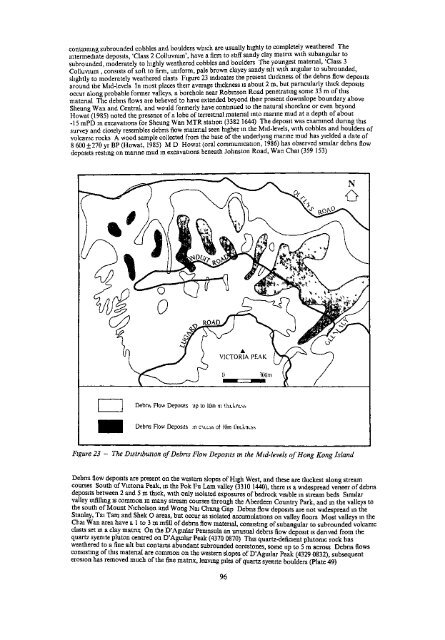Superficial Geology
Superficial Geology
Superficial Geology
Create successful ePaper yourself
Turn your PDF publications into a flip-book with our unique Google optimized e-Paper software.
containing subrounded cobbles and boulders which are usually highly to completely weathered The<br />
intermediate deposits, 'Class 2 Colluvmm', have a firm to stiff sandy clay matrix with subangular to<br />
subrounded, moderately to highly weathered cobbles and boulders The youngest material, 'Class 3<br />
Colluvium , consists of soft to firm, uniform, pale brown clayey sandy silt with angular to subrounded,<br />
slightly to moderately weathered clasts Figure 23 indicates the present thickness of the debris flow deposits<br />
around the Mid-levels In most places their average thickness is about 2 m, but particularly thick deposits<br />
occur along probable former valleys, a borehole near Robinson Road penetrating some 33 m of this<br />
material The debris flows are believed to have extended beyond their present downslope boundary above<br />
Sheung Wan and Central, and would formerly have continued to the natural shoreline or even beyond<br />
Howat (1985) noted the presence of a lobe of terrestrial material into marine mud at a depth of about<br />
-15 mPD in excavations for Sheung Wan MTR station (3382 1644) The deposit was examined during this<br />
survey and closely resembles debris flow material seen higher in the Mid-levels, with cobbles and boulders of<br />
volcanic rocks A wood sample collected from the base of the underlying marine mud has yielded a date of<br />
8 600 ±270 yr BP (Howat, 1985) M D Howat (oral communication, 1986) has observed similar debris flow<br />
deposits resting on marine mud m excavations beneath Johnston Road, Wan Chai (359 153)<br />
Debris Flow Deposits up to 10m in thickness<br />
Debris Flow Deposits<br />
in excess of 10m thickness<br />
Figure 23 - The Distribution of Debris Flow Deposits in the Mid-levels of Hong Kong Island<br />
Debris flow deposits are present on the western slopes of High West, and these are thickest along stream<br />
courses South of Victoria Peak, m the Pok Fu Lam valley (3310 1440), there is a widespread veneer of debris<br />
deposits between 2 and 5 m thick, with only isolated exposures of bedrock visible m stream beds Similar<br />
valley infilling is common in many stream courses through the Aberdeen Country Park, and in the valleys to<br />
the south of Mount Nicholson and Wong Nai Chung Gap Debris flow deposits are not widespread m the<br />
Stanley, Tai Tarn and Shek O areas, but occur as isolated accumulations on valley floors Most valleys in the<br />
Chai Wan area have a 1 to 3 m infill of debris flow material, consisting of subangular to subrounded volcanic<br />
clasts set m a clay matrix On the D'Aguilar Peninsula an unusual debris flow deposit is derived from the<br />
quartz syenite pluton centred on D'Aguilar Peak (4370 0870) This quartz-deficient plutonic rock has<br />
weathered to a fine silt but contains abundant subrounded corestones, some up to 5 m across Debris flows<br />
consisting of this material are common on the western slopes of D'Aguilar Peak (4329 0832), subsequent<br />
erosion has removed much of the fine matrix, leaving piles of quartz syenite boulders (Plate 49)<br />
96

















